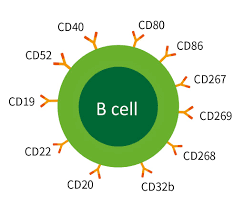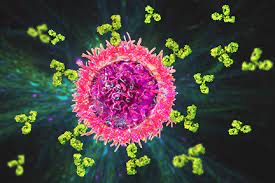
 Derived from the bone marrow and mature through sequential steps.
Derived from the bone marrow and mature through sequential steps.
The development of B-cells originates from pluripotent stem cells from the bone marrow.
B cells that successfully build their immunoglobulin heavy chains migrate to the germinal centers to allow for antibody diversification by somatic hypermutation.
Stem cells mature into pro-B cells, pre-B cells and immature B cells
Enters the blood stream as transitional cells and migrate to secondary lymphoid organs.
Cells that survive in the lymphoid organs become naive B cells and can mount a rapid low affinity antibody response to bacterial cell wall antigens.
The surface of each B-lymphocyte contains around 10,000 protein complexes called membrane-bound antibodies, called immunoglobulins.
All the membrane-bound antibodies for one particular B-cell are the same; however, between B-cells, the antibodies vary slightly in their variable portion, meaning that there is a lot of diversity among B-cell membrane-bound antibodies ranging to several billion.
B cell cancers are a diverse group of clinical and pathological processes that arise from the B (bursal or bone marrow derived) lymphocytes of the immune system.
B cells involved in humoral immunity and are part of the adaptive immune response.
B cells display B-cell receptors (BCR) on the surface which binds to a specific antigen.
Antigen binding of B-cells activates clonal expansion, during which production of the cells forms clones that secrete same antibody.
Antibodies that are formed can bind to target antigens on foreign cells and initiate immune responses that can destroy those cells.
The BCR is composed of surface-bound IgD or IgM antibodies and associated Ig-α and Ig-β heterodimers, which are capable of signal transduction.
A typical human B cell will have 50,000 to 100,000 antibodies bound to its surface.
All the membrane-bound antibodies for one particular B-cell are the same; however, between B-cells, the antibodies vary slightly in their variable portion, meaning that there is a lot of diversity among B-cell membrane-bound antibodies ranging to several billion.
When a foreign invader/antigen enters the body, such as a disease-causing bacteria or virus, there would likely be a B-cell with the right membrane-bound antibodies available to attach to it.
B cells arise in the bone marrow from hematopoetic stem cells and culminate after several stages of development culminating in the formation of B cells in the spleen.
Subsets noted in the bone marrow, marginal zone of the spleen and lymph nodes, and circulating in the peripheral blood.
Some B cells after exposure to protein antigen and with T cell help express higher affinity antibodies in the germinal center, the site where such cells are selected and expand.
B cells of the rapid antibody response and the T-cell dependent pathway B cells are regulated by antigen presenting cells (APCs) of different lineages.
Recognize native, on processed antigens using B-cell receptor.
Products of germinal center may differentiate into memory B cells or via plasmablasts into antibody producing plasma cells.
Lymphocyte whose purpose is to make antibodies.
Recognizes antigen through surface immunoglobulins and then presents antigens to T cells.
Produces antibodies, directly effects behavior of other cells in the immune system and indirectly effects the immune system through antigen presentation and production of cytokines.
During an immune response somatic point mutations occur in the immunoglobulin genes of the B cell allowing changes in binding sites of the antibody to fit its target antigen effectively.
Somatic mutations in the immunoglobulins occur in the germinal centers of the peripheral lymphoid tissue and indicate that the B cell has passed through that area.
Mature B cells express CD19, CD 20, and CD 21.
Neoplastic mature B lymph cells can be distinguished from normal cells by identifying phenotype abnormalities including immunoglobulin light chain class restriction and aberrant antigen expression.
Neoplasms of mature B cells usually arise from a single clone of cells and express only one class of immunoglobulin light chain-kappa or lambda.
Many B-cell malignancies due to days regulation of normal development and maturation processes.
